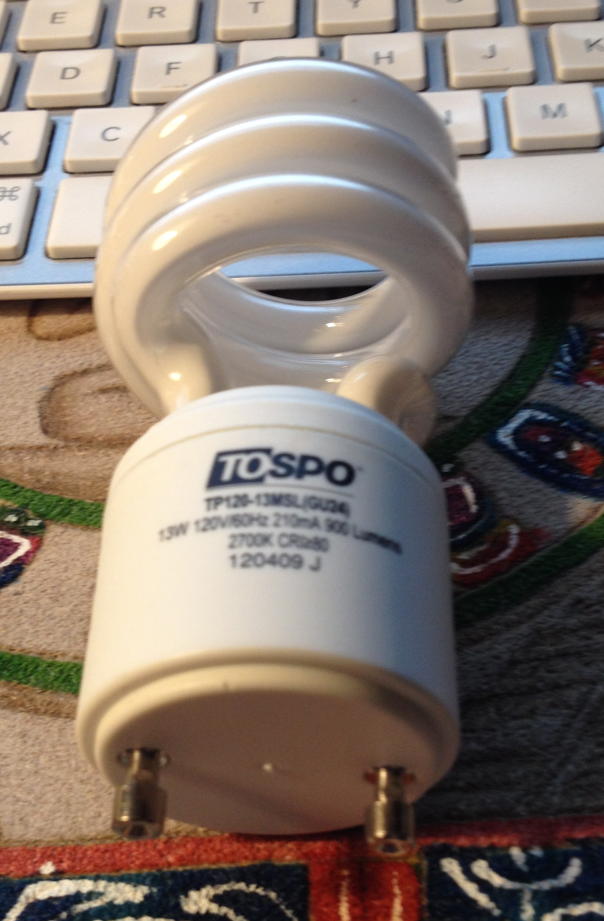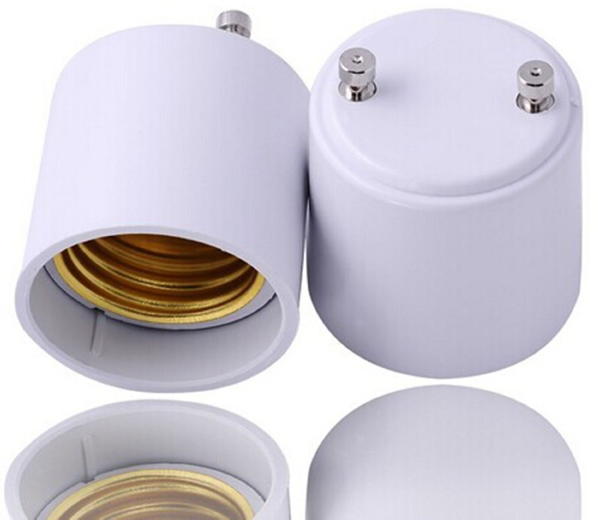GU24: Government-enforced energy-wasting lamps

Government technology, bringing you the marvels of yesterday today!
We just had a hallway ceiling light go out; the way it flickered before going dark let me know it was a fluorescent bulb, and I looked forward to replacing it with one of the newer, less expensive and more energy-saving LED bulbs I’ve got in the closet for just such an opportunity.
Until I pulled it out and saw the two-legged alien creature inside. I was right about the fluorescent—it’s a 13-watt compact fluorescent bulb, 60-watt. Perfect for replacing with one of the cooler 10-watt LEDs in the closet. Except, of course, that none of them will fit as a replacement.
I did a quick search on two-pronged light bulb and discovered that this is a GU24 pin-base that “ensures that lighting systems intended for high-efficiency lamps cannot be used with incandescent lamps”. This is government-driven technology change. California, for example, in 2008, basically required the use of them for “all residential remodels and new construction”.
A high efficacy lamp screwed into a low efficacy luminaire will still be considered to be a low efficacy lighting system for Title 24 projects.
It was a government plan to enforce low-energy lighting, yet, now, in the socket that has one of these, I’m probably going to have to put in a 30% more power-hungry bulb than if it had the standard screw-in socket. A bulb that will have to be thrown out sooner, and that contains mercury.
Back in 2011 BuildingGreen.com claimed that GU24 sockets were “gaining momentum”. But their bulbs remain expensive now, three years later—especially for the better LED bulbs. GU24 LED bulbs do exist, but instead of costing $4.49 from Ikea the cheapest I’ve been able to find is a $23.95 one on Amazon. So either I buy an adapter and risk extending the length of the socket too much for the fixture, or I get a $5.78 fluorescent that uses more power and will have to be thrown out sooner.
This is what happens when government enforces a technology: technology moves much faster than government, and the mandate eventually breaks what it was meant to fix.
- December 8, 2014: GU24 to Edison adapter
-
Since the GU24 adapter on Amazon• was less than two bucks, even with shipping from China, I decided I’d try that before rewiring the whole system. It just arrived last week (it took about eight weeks to get here), so I have a nice, inexpensive LED bulb in the GU24 adapter.
As a bonus, it no longer takes a second or two and then some flickering to light the hallway after flipping the switch.
I’d like to say here, I’m not averse to the Edison-bulb connector going away and being replaced with something better. I’ve had too many incandescents get stuck, requiring so much force to unscrew that the bulb itself starts to break. But the way to fix that is not to enforce a different connector on bulbs that most people don’t want to use. If GU24—or any future new connector—is advantageous, it should be allowed to be advantageous on all bulbs, not just the ones that government in its love of complex technologies thinks will never be superseded by something better.
If GU24 had been allowed for incandescents as well, it might well have taken off enough for LED bulbs using it to be less expensive—if GU24 provides actual benefits over the Edison-style. But because the government forbade using GU24 with the light bulb most commonly used in homes, it’s likely we’re stuck with the older style for the foreseeable future.
- GU24 connector at Wikipedia
- “A GU24 connector is fitting for compact fluorescent light bulbs (CFL) or LED bulbs that uses a bayonet mount-like twist-lock bi-pin connector instead of the Edison screw fitting used on many incandescent light bulbs.”
- GU24: New Pin-Base for CFLs, LEDs: Evan Dick
- “A relatively new type of pin-based light fixture, called the GU24 base, ensures that lighting systems intended for high-efficiency lamps cannot be used with incandescent lamps. GU24 base socket-lamp combinations are gaining momentum as the new standard for lighting—guaranteeing energy savings beyond the life of one lamp.”
- Lighting Facts—Bulb Comparison Chart
- Incandescents, CFLs, and LEDs compared.
More Eloi class
- The Life of Stephen A. Douglas
- Where Abraham Lincoln’s conservative principles made a flawed man better, Stephen A. Douglas’s belief in the responsibility of government elites for managing lesser men made him far worse.
- Mitt Romney Day 2020: Coronavirus Calvinball
- The competition for the Mitt Romney Day award in 2020 became dangerously competitive come March, as contestants worked hard to kill the most jobs, the most small businesses, the most lives. But there can be only one winner.
- The new barbarism: A return to feudalism
- The progressive left seems to have no concept of what civilization is, and of what undergirds civilization.
- The Tyranny of the New York Times
- The New York Times joins CNN in its totalitarian views of the use of rules.
- Was Weinstein treated better than Spacey because his accusers were women?
- Both Weinstein and Spacey got a pass for a long time. We know more about Weinstein because he was caught earlier, and that’s it. Maybe it’s past time to drain the swamps of Hollywood, the entertainment industry in general, and similar cultures of deception such as in Washington DC.
- 25 more pages with the topic Eloi class, and other related pages
More lights
- Battery-operated floor lamp
- A battery-operated lamp removes the need for unsightly and even dangerous cords.
- GU24 to Edison adapter
- The GU24 adapter for our hall light arrived from Amazon last week. It works great.
More technology lockdown
- Future Snark
- Why does the past get the future wrong? More specifically, why do expert predictions always seem to be “hand your lives over to technocrats or we’ll all die?”
- The presumption of ignorance
- From movie theaters to classrooms to jury rooms, there’s an assumption that forced ignorance is possible. But it isn’t, it never has been, and it’s only going to get more obvious.
- Can schools compete with the Internet by clicking?
- Fat, drunk, and clicking is no way to go through life.

